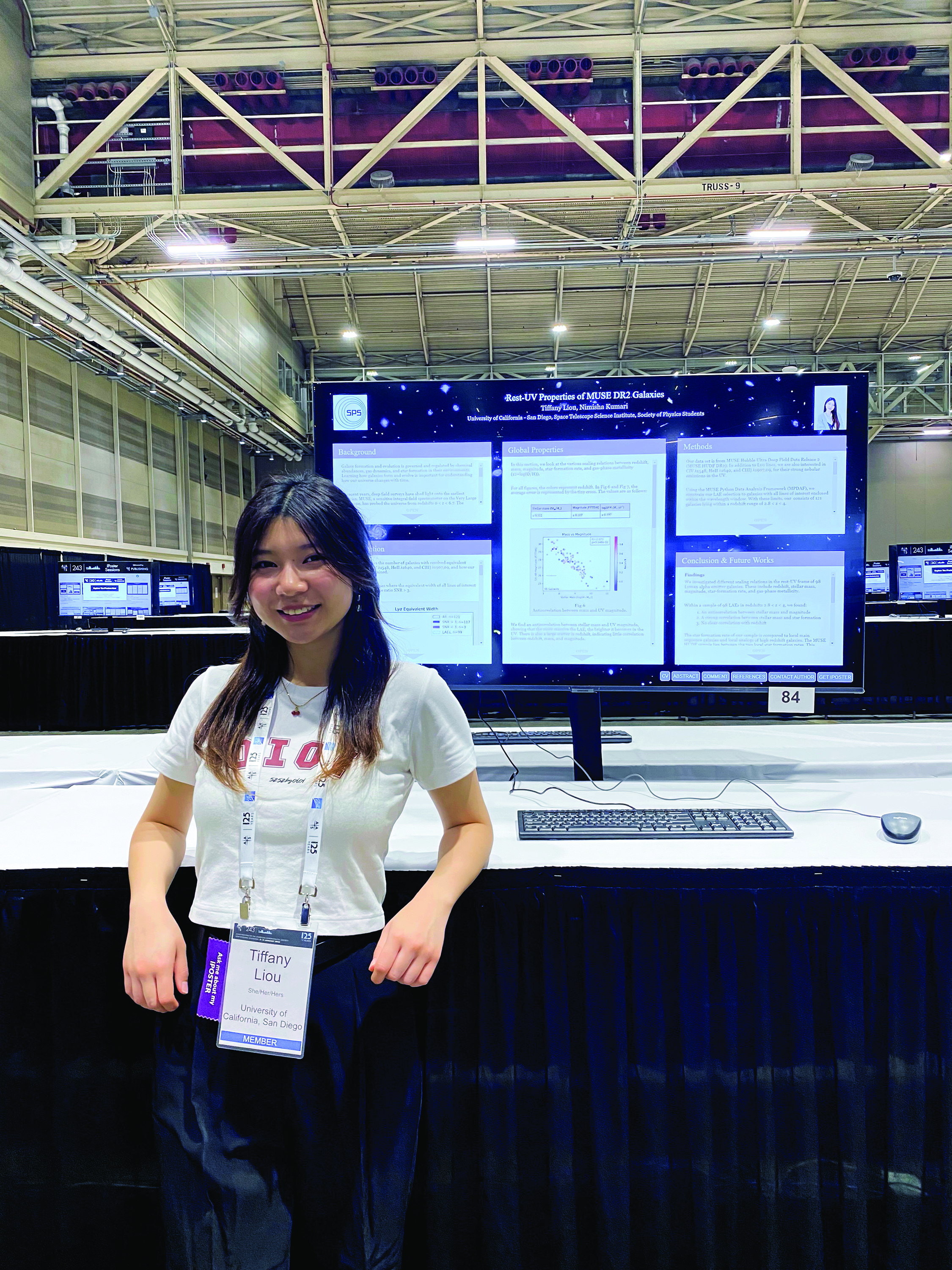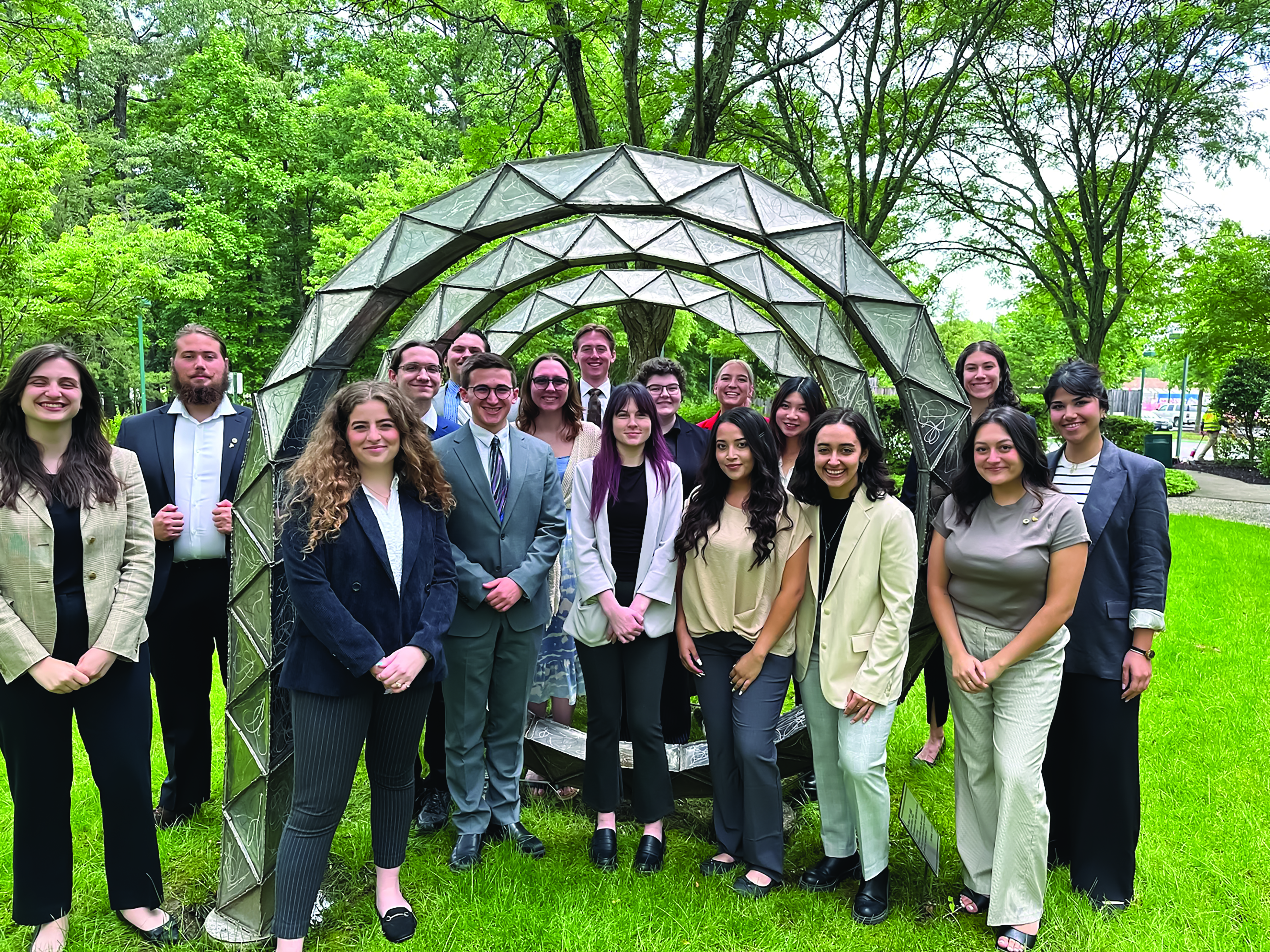Lyman-Alpha Emitters Offer a Peek into Galactic Evolution
Fall
2024
Building Blocks - Undergraduate Research and Outreach Projects
Lyman-Alpha Emitters Offer a Peek into Galactic Evolution
Tiffany Liou, 2023 SPS Summer Intern, Space Telescope Science Institute, and Past SPS Chapter President, University of California, San Diego
A5 - Building Blocks - Lyman2.jpg

This color image shows the Hubble Ultra Deep Field region as observed with the MUSE instrument on the European Southern Observatory’s Very Large Telescope. This picture only gives a very partial view of the MUSE data, which also includes a spectrum for each pixel in the picture. This data set has allowed astronomers to measure distances for far more of these galaxies than before and to learn much more about them. Image by the ESO/MUSE HUDF collaboration.
“How did this happen?” You might ask that question when your clothes shrink in the dryer or when you contemplate the fate of the universe. One of the main goals of physics and astronomy is to understand how things change over time, whether it be during the dryer cycle or on the nano to cosmological timescale. The study of galactic evolution aims to address this big question.
Our universe was built on a series of violent dynamical processes such as fusion and mergers. Such processes lead to the formation of galaxies, and their evolution is governed and regulated by the chemical abundances, gas dynamics, and star formation in their environments. Learning how galaxies form and evolve is therefore essential to understanding how the universe changes over time.
In the summer of 2023, I immersed myself in astronomical research through an SPS summer internship based in Washington, DC. I worked at the Space Telescope Science Institute (STScI), a research institute that specializes in various subfields of physics and astronomy, alongside astronomer Nimisha Kumari to explore the field of galactic evolution.
At STScI I studied the rest-ultraviolet properties of Lyman-alpha emitters (LAEs) to learn about galactic evolution. LAEs are galaxies characterized by strong Lyman-alpha (Lyα) emission lines, which occur when a hydrogen atom transitions from the second energy level to the ground-state energy level. They have high star-formation rates and low metallicities for their compact size. We studied high-redshift LAEs, which means they are among the earliest galaxies that formed in the universe.
If the intergalactic medium (IGM) of the early universe was mostly neutral hydrogen, then it would have scattered the Lyα photons emitted by these galaxies, making them undetectable by telescopes today. However, we can see them. The Lyα photons are able to escape the neutral IGM and reach our telescopes because of their highly ionized nature. This interesting feature makes LAEs popular candidates for probing the early conditions of the IGM and the environment surrounding galaxies.
To explore the properties of the LAEs, I used observational data from the MUSE Hubble Ultra Deep Field (MUSE HUDF DR2). MUSE is a ground-based spectrometer located on the Very Large Telescope in Chile. The data includes spectra from redshifts between 0 and 6.7. I focused on 98 LAEs between redshifts 2.8 and 4 whose spectra contained the lines I was interested in (Lyα, CIV λ1549,50, HeII λ1640, and CIII] λ1907,9) within the wavelength window I was studying.
After sifting through the galaxies that fit my wavelength criteria, I studied the scaling relations between the physical properties of my galaxy sample: mass, UV luminosity, star-formation rate, gas-phase metallicity, and redshift. For example, I found an inverse relationship between mass and luminosity, meaning that as the galaxies get more massive, they get brighter in the UV.
One of my most interesting findings relates to star-formation rates. I compared my LAEs to two types of local galaxies, typical “main sequence” galaxies (a group that includes our Milky Way) and local analogs, which may have similar properties to high-redshift galaxies (from the COS Legacy Archive Spectroscopy Survey, CLASSY). My sample had higher star-formation rates than local main sequence galaxies, as expected, but lower star-formation rates than the local analogs. This could mean that the local analogs are not representative of LAEs within our redshift range, or that the star-formation rate peaks around a redshift of 3 and my sample falls on the opposite side of the peak. It is also interesting that the relations for mass, star formation, and luminosity have little correlation to redshift.
Through this project the main lessons I learned are that the research process is nonlinear and that I can do it! When I first started, I felt a little bit timid—I didn’t think observational astronomy was my strongest field. However, by investing time and asking lots of questions, I witnessed myself grow, not only in terms of the project but also as a scientist. My mentor, Dr. Kumari, provided a lot of support, helping me gain a conceptual understanding of the field and learn research methods and the main functionalities of observational instruments like MUSE.
I also learned that research doesn’t always go as planned. One of my goals was to estimate the gas-phase metallicity of my LAE sample using specific emission lines. In my samples, however, those lines did not show up strong and resolved, so I was unable to draw solid conclusions. This was disappointing at first, but I realized that no information is still information. In addition, this knowledge can guide future research. The gap in my findings encourages me to stay curious and investigate more!
I presented a poster on my findings at the 243rd American Astronomical Society (AAS) Meeting in New Orleans, Louisiana, over the winter. It was such a fruitful experience to share my research with astronomers from various subfields and adapt my presentation for different audiences. I also learned more about this area of research and the possible implications of my results through discussions with experts in galactic evolution. At the meeting I received the AAS Chambliss Astronomy Achievement Student Award for exemplary research. This award means a lot to me because it showcased my growth in research and science communication.
Participating in the SPS internship program was one of the most influential experiences of my undergraduate career. My project with Dr. Kumari allowed me to try out a new area of astronomy and helped me realize my passion for astronomical research. I also gained exposure to other disciplines in physics and expanded my views on how physics fits into the world through the SPS internship program. While I was at STScI, others in my SPS internship cohort were stationed at Capitol Hill, the American Institute of Physics, the American Physical Society, NIST (the National Institute of Standards and Technology), and the Niels Bohr Library & Archives. The variety of projects was eye-opening, and I learned about areas of physics that I had never considered before. If you are reading this, this is your sign to apply to summer internships and research experiences and explore new topics!
Publish Your Research
The Journal of Undergraduate Research in Physics and Astronomy (JURPA) is a peer-reviewed publication of the Society of Physics Students that consists of papers by undergraduate researchers. Manuscripts are accepted on a rolling basis but must be submitted by March 15 each year for print consideration. Learn more at spsnational.org/jurpa.
SPS Award for Outstanding Undergraduate Research
These awards recognize individuals for exceptional physics or astronomy research conducted as an undergraduate. Winners receive $2,000 in travel funding to present their research, $500 for themselves, and $500 for their SPS chapter. Applications are due March 15 each year. Learn more at spsnational.org/awards/outstanding-undergraduate-research.
Be an SPS Summer Intern
The SPS summer internship program offers 10-week, paid positions for undergraduate physics and astronomy students in science research, education, outreach, and policy. Interns are placed with organizations in the greater Washington, DC, area that do research, engage with the community, and promote the advancement of physics and astronomy. Applications are due January 15 each year. Learn more at spsnational.org/programs/internships.
More from this department
Building Blocks - Undergraduate Research and Outreach Projects


